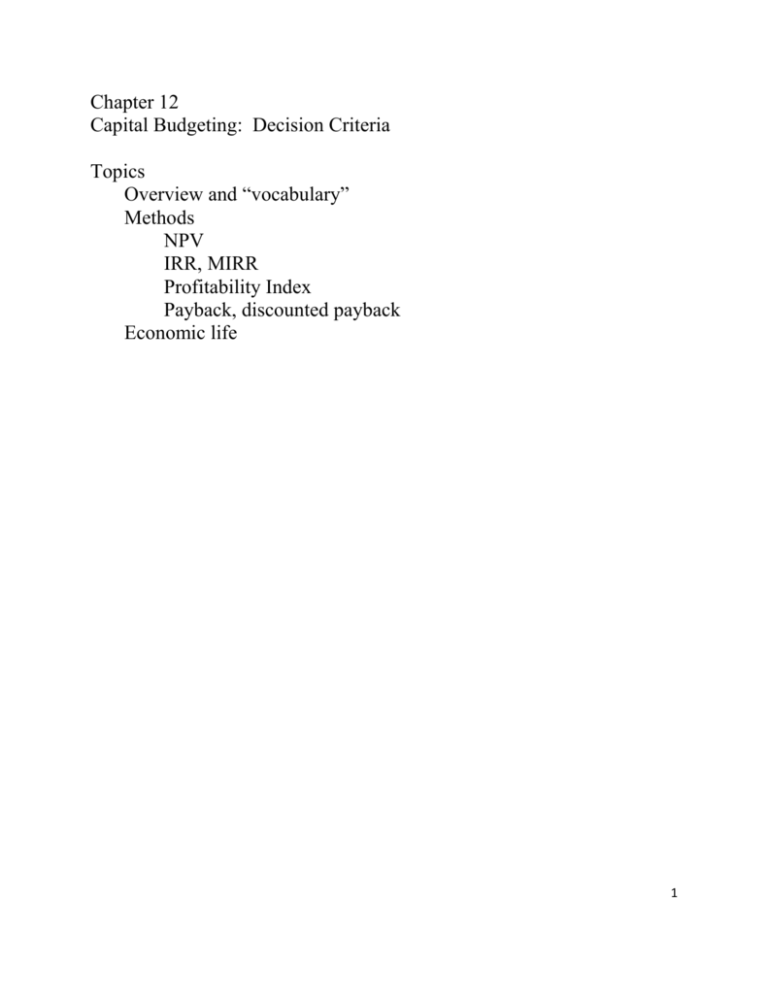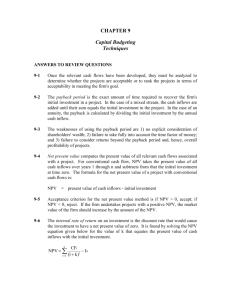Chapter 12 Capital Budgeting: Decision Criteria Topics Overview
advertisement

Chapter 12 Capital Budgeting: Decision Criteria Topics Overview and “vocabulary” Methods NPV IRR, MIRR Profitability Index Payback, discounted payback Economic life 1 What is capital budgeting? Analysis of potential projects. Long-term decisions; involve large expenditures. Very important to firm’s future. Independent versus Mutually Exclusive Projects Projects are: independent, if the cash flows of one are unaffected by the acceptance of the other. mutually exclusive, if the cash flows of one can be adversely impacted by the acceptance of the other. Net Present Value NPV: Sum of the PVs of all cash flows. Rationale for the NPV Method NPV = PV inflows – Cost This is net gain in wealth, so accept project if NPV > 0. Choose between mutually exclusive projects on basis of higher NPV Adds most value. 2 Ex: Cash Flows for Franchise L and Franchise S What’s Franchise L’s NPV? Calculator Solution: Enter values in CFLO register for L. Using NPV method, which franchise(s) should be accepted? If Franchise S and L are mutually exclusive, accept S because NPVs > NPVL . If S & L are independent, accept both; NPV > 0. 3 Internal Rate of Return: IRR - the discount rate that forces PV of inflow =cost. NPV = 0 Note NPV: Enter r, solve for NPV. Rationale for the IRR Method If IRR > WACC, then the project’s rate of return is greater than its cost-- some return is left over to boost stockholders’ returns. What’s Franchise L’s IRR? Decisions on Projects S and L per IRR If S and L are independent, accept both: IRRS > r and IRRL > r. If S and L are mutually exclusive, accept S because IRRS > IRRL . 4 Construct NPV Profiles Enter CFs in CFLO and find NPVL and NPVS at different discount rates: r NPVL NPVS 0 50 40 5 33 29 10 19 20 15 7 12 20 (4) 5 NPV Profile 50 40 NPV ($) 30 20 10 0 0 -10 5 10 15 20 23.6 Discount rate r (%) 5 NPV and IRR: Independent projects. No conflict for independent projects Mutually Exclusive Projects 6 To Find the Crossover Rate Find cash flow differences between the projects. If profiles don’t cross, one project dominates the other. Reinvestment Rate Assumptions NPV assumes reinvest at r (opportunity cost of capital). IRR assumes reinvest at IRR. Reinvest at opportunity cost, r, is more realistic, so NPV method is best. NPV should be used to choose between mutually exclusive projects. 7 Modified Internal Rate of Return (MIRR) MIRR - the discount rate which causes the PV of a project’s terminal value (TV) to equal the PV of costs. TV is found by compounding inflows at WACC. Thus, MIRR assumes cash inflows are reinvested at WACC. MIRR Steps: 1. Find NPV of all cash inflows 2. Find TV of those inflows ==> Take NPV in 1. & find the FV 3. Find PV of all cash outflows 4. Find IRR FV =TV of inflows (found in 2.) PV =PV of outflows (found in 3.) 8 Ex: MIRR for Franchise L: Find PV and TV (r = 10%) Step 1, find PV of Inflows First, enter cash inflows in CFLO register: CF0 = 0, CF1 = 10, CF2 = 60, CF3 = 80 Enter I/YR = 10. Find PV of inflows: Press NPV = 118.78 Step 2, find TV of inflows. Enter PV = -118.78, N = 3, I/YR = 10, PMT = 0. Press FV = 158.10 = FV of inflows. Timeline: 9 Find discount rate that equates PV and TV Step 3, find PV of outflows. For this problem, there is only one outflow, CF0 = -100, so the PV of outflows is -100. Note: For other problems there may be negative cash flows for several years, and you must find the present value for all negative cash flows. Step 4, find “IRR” of TV of inflows and PV of outflows. Enter FV = 158.10, PV = -100, PMT = 0, N = 3. Press I/YR = 16.50% = MIRR. Why use MIRR versus IRR? MIRR correctly assumes reinvestment at opportunity cost = WACC. MIRR also avoids the problem of multiple IRRs. Managers like rate of return comparisons, and MIRR is better for this than IRR. 10 Normal vs. Nonnormal Cash Flows Normal Cash Flow Project: One change of signs. Cost (negative CF) followed by a series of positive cash inflows. Nonnormal Cash Flow Project: two or more changes of signs. Most common: Cost (negative CF), then string of positive CFs, then cost to close project. For example, nuclear power plant or strip mine. Nonnormal CFs--two sign changes, two IRRs. When there are nonnormal CFs (more than one IRR) use MIRR. 11 Profitability Index The profitability index (PI) is the present value of future cash flows divided by the initial cost. It measures the “bang for the buck.” Franchise L’s PV of Future Cash Flows Franchise L’s Profitability Index Payback Period The number of years required to recover a project’s cost, or how long does it take to get the business’s money back? Strengths of Payback Provides an indication of a project’s risk and liquidity. Easy to calculate and understand. Weaknesses: Ignores the TVM. Ignores CFs occurring after the payback period. 12 Ex: Payback for Franchise L Payback for Franchise S Discounted Payback: Uses discounted rather than raw CFs. 13 Economic Life versus Physical Life Consider another project with a 3-year life. If terminated prior to Year 3, the machinery will have positive salvage value. Should you always operate for the full physical life? Economic Life versus Physical Life Year CF Salvage Value 0 ($5000) $5000 1 2,100 3,100 2 2,000 2,000 3 1,750 0 CFs Under Each Alternative 0 1 2 3 1. No termination (5000) 2100 2000 1750 2. Terminate 2 years (5000) 2100 4000 3. Terminate 1 year (5000) 5200 NPVs under Alternative Lives (Cost of capital = 10%) NPV(3) = -$123. NPV(2) = $215. NPV(1) = -$273. Conclusions The project is acceptable only if operated for 2 years. A project’s engineering life does not always equal its economic life. 14 Choosing the Optimal Capital Budget Finance theory says to accept all positive NPV projects. Two problems can occur when there is not enough internally generated cash to fund all positive NPV projects: 1. An increasing marginal cost of capital. 2. Capital rationing Increasing Marginal Cost of Capital Externally raised capital can have large flotation costs, which increase the cost of capital. Investors often perceive large capital budgets as being risky, which drives up the cost of capital. If external funds will be raised, then the NPV of all projects should be estimated using this higher marginal cost of capital. Capital Rationing Capital rationing occurs when a company chooses not to fund all positive NPV projects. The company typically sets an upper limit on the total amount of capital expenditures that it will make in the upcoming year. 15









